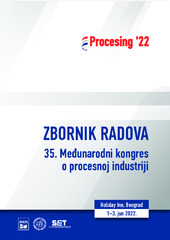Приказ основних података о документу
To be free or not to be free: cross-linking of potato peel peroxidase for “green” degradation of anthraquinone dye
Imobilizacija peroksidaze iz krompirovih ljuski u obliku umreženih enzimskih agregata za “zelenu” razgradnju antrahinonske boje
| dc.creator | Svetozarević, Milica | |
| dc.creator | Šekuljica, Nataša | |
| dc.creator | Dajić, Ana | |
| dc.creator | Mihajlović, Marina | |
| dc.creator | Knežević-Jugović, Zorica | |
| dc.creator | Mijin, Dušan | |
| dc.date.accessioned | 2023-10-06T10:22:03Z | |
| dc.date.available | 2023-10-06T10:22:03Z | |
| dc.date.issued | 2022 | |
| dc.identifier.isbn | 978-86-85535-12-3 | |
| dc.identifier.uri | http://TechnoRep.tmf.bg.ac.rs/handle/123456789/6652 | |
| dc.description.abstract | Enzyme immobilization is a convenient technique for reuse of enzymes –it is one of the advantages that contributes for enhanced productivity and efficacy of these processes. Enzyme stability and their recovery from a reaction mixture are just a couple of the many benefits that can be acquired by immobilization [1]. These features give opportunity for enzymatic application at industrial scale. The enzyme used in this study is perox-idase, an oxidoreductase that oxidizes variety of organic pollutants such as: phenols, textile dyes and phar-maceutically active compounds[2]. The use of potato peel as a source of peroxidase for degradation of textile dye contributes to the sustainability of the treatment. The simple isolation of peroxidase as a crude extract adds up to the cost effectiveness of the product (peroxidase).Given the fact that peroxidase is an eco-friendly biocatalyst, an effort is made to find a suitable ‘green’ way of immobilization. Glutaraldehyde is the most common cross-linker used for the same kind of immobilization [3]. However, it is a toxic compound, so it is replaced by alternative compounds such as natural polysaccharides. One of them is pectin that can be oxidized in order to introduce aldehyde groups, which in turn react with the amino-groups from the amino-acid residues and form Schiff bases [4], [5]. Afterwards, the cross-linked peroxidase can be applied for oxidation reaction.In this study, peroxidase was isolated from waste material –potato peel as a crude extract. The enzy-matic crude extract was precipitated with different reagents, in order to find the most suitable one. Next, the influence of the cross-linker concentration was examined. The cross-linked potato peel peroxidase was used for biodegradation of the anthraquinone dye Acid Violet 109. The process parameters: pH, reaction time, enzyme, hydrogen peroxide and dye concentration were optimized for achieving the maximal degradation rate. The operational stability, as a key parameter in immobilized systems was also examined. | sr |
| dc.description.abstract | Boje koje se koriste u tekstilnoj industriji predstavljaju opasnost po životnu sredinu zbog toga što veći deo na kraju završi u vodotokovima. Kako konvencionalne tretmane karakteriše potreba za velikim količinama reagenasa, visoki troškovi procesa kao i pojava značajnih količina otpadnih materija na kraju procesa, stalno se radi na pronalasku novih efikasnijih tretmana otpadne vode. Za razliku od klasičnih tretmana, primena enzima, kao ekološki benignih biokatalizatora, predstavljaju „zeleno“ rešenje ovog problema. Kako bi se smanjili troškovi proizvodnje enzima predložena je njihova izolacija iz otpadnih materijala. Dugotrajni, komplikovani postupci prečišćavanja otpadnih materijala mogli bi se zaobići izolacijom u obliku sirovog ekstrakta. Imobilizacija enzima omogućila bi njihovu višekratnu upotrebu što bi doprinelo efikasnosti procesa. U izvedenim eksperimentima, ispitan je uticaj taložnog reagensa i koncentracije sredstva za umrežavanje na aktivnost enzima i efikasnost imobilizacije. Nakon umrežavanja, enzimski agregati su su korišćeni za razgradnju boje Acid Violet 109 i optimizovani su sledeći parametri: pH, koncentracija enzima, koncentracija vodonik-peroksida i koncentracija boje. Tokom eksperimenata ispitana je i operativna stabilnost umreženih agregartata. | sr |
| dc.language.iso | en | sr |
| dc.publisher | Beograd : Savez mašinskih i elektrotehničkih inženjera i tehničara Srbije (SMEITS), Društvo za procesnu tehniku | sr |
| dc.rights | openAccess | sr |
| dc.rights.uri | https://creativecommons.org/licenses/by-nc-sa/4.0/ | |
| dc.source | Zbornik radova / 35. Međunarodni kongres o procesnoj industriji, PROCESING '22, 1-3. jun 2022, Beograd | sr |
| dc.subject | peroxidase | sr |
| dc.subject | cleaner production | sr |
| dc.subject | agroindustrial waste | sr |
| dc.subject | anthraquinone dye | sr |
| dc.subject | peroksidaza | sr |
| dc.subject | čistija proizvodnja | sr |
| dc.subject | poljoprivredni otpad | sr |
| dc.subject | antrahinonska boja | sr |
| dc.title | To be free or not to be free: cross-linking of potato peel peroxidase for “green” degradation of anthraquinone dye | sr |
| dc.title | Imobilizacija peroksidaze iz krompirovih ljuski u obliku umreženih enzimskih agregata za “zelenu” razgradnju antrahinonske boje | sr |
| dc.type | conferenceObject | sr |
| dc.rights.license | BY-NC-SA | sr |
| dc.citation.epage | 146 | |
| dc.citation.spage | 141 | |
| dc.identifier.fulltext | http://TechnoRep.tmf.bg.ac.rs/bitstream/id/17958/To_be_free_pub_2022.pdf | |
| dc.identifier.rcub | https://hdl.handle.net/21.15107/rcub_technorep_6652 | |
| dc.type.version | publishedVersion | sr |

